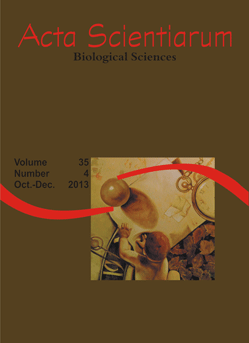<b>Flagellate protist abundance in phytotelmata of <i>Aechmea distichantha</i> Lem. (Bromeliaceae) in the upper Paraná river basin</b> - doi: 10.4025/actascibiolsci.v35i4.17134
Abstract
In some Bromeliaceae species the leaf sheaths form a tank or phytotelma, accumulating water and organic detritus, conditions that allow the establishment of different communities. Thus, this study evaluated the relationship between diameter and volume of water in the tank of the bromeliad Aechmea distichantha Lem. and density of flagellates found in the phytotelmata, as well as the influence of the hydrological periods and proximity of sampled strata on the phytotelma patterns of abundance distribution. Samplings were conducted in two hydrological periods in 2010. In each sampling, four plants were collected from three different strata, classified according to the distance from the river level. A one-way ANOVA identified significant differences in flagellate density between hydrological periods. The influence of the water volume in the phytotelmata on the flagellate density was evidenced by regression analyses, as well as the lack of relationship between the density and perimeter of the tank. Moreover, the distance of the strata from the river level did not influence the pattern of flagellate abundance. Thus, our results suggested that the hydrological period and the volume of water in the tanks of Aechmea distichantha are determinant on the abundance of heterotrophic flagellate in the phytotelmata.
Downloads
DECLARATION OF ORIGINALITY AND COPYRIGHTS
I Declare that current article is original and has not been submitted for publication, in part or in whole, to any other national or international journal.
The copyrights belong exclusively to the authors. Published content is licensed under Creative Commons Attribution 4.0 (CC BY 4.0) guidelines, which allows sharing (copy and distribution of the material in any medium or format) and adaptation (remix, transform, and build upon the material) for any purpose, even commercially, under the terms of attribution.
Read this link for further information on how to use CC BY 4.0 properly.












1.png)




3.png)













